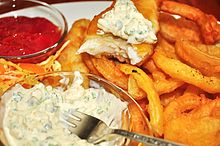Tartar sauce (French: sauce tartare; spelled tartare sauce in the UK, Ireland, and Commonwealth countries) is a condiment made of mayonnaise, chopped pickles and relish, caper, and herbs such as tarragon and dill. Tartar sauce can also be enhanced with other herbs, lemon juice, and olives. It is most often served with seafood dishes such as fish and chips, fish sandwiches, fish fingers, fried oysters, and calamari.[1]

Tartar sauce is often served with fried seafood dishes.
| |
| Alternative names | Tartare sauce, tartare |
|---|---|
| Type | Sauce |
| Place of origin | France |
| Main ingredients | Mayonnaise, gherkins (or other varieties of pickles), lemon juice and sometimes tarragon |
|
| |
Tartar sauce is based on either mayonnaiseoraioli, with certain other ingredients added. In the UK, recipes typically add to the base capers, gherkins, lemon juice, and dill. US recipes may include chopped dill pickles, onions (orchives), and fresh parsley.[1] Chopped hard-boiled eggs or olives are sometimes added, as may be Dijon mustard and cocktail onions.[2] Hungarian variants may include sour cream (alternatively, cream), powdered sugar, white pepper and white wine besides the other core ingredients.
Tartar sauce is named for steak tartare, with which it was commonly served in 19th century France.[3] Recipes for tartar sauce have been found in English-language cookbooks dating to the mid-19th century,[4] including a recipe in Modern Cookery for Private Families in 1860.[5] It was also popular in Hungary in the late 19th century.[6]
sauce tartare.
{{cite book}}: CS1 maint: location missing publisher (link)
This condiment-related article is a stub. You can help Wikipedia by expanding it. |